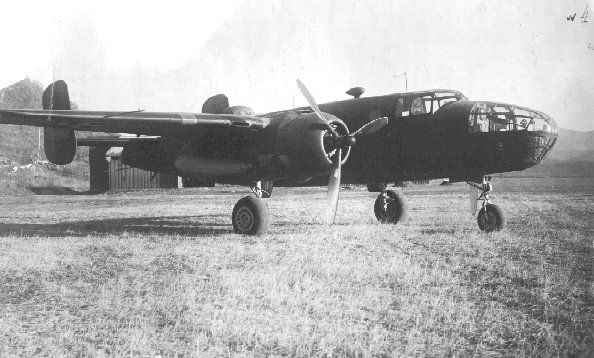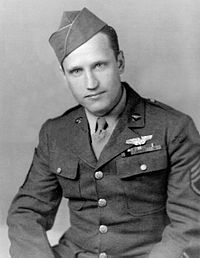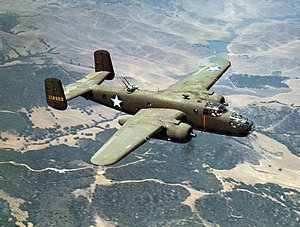Within 24 hours of the Japanese
surprise attack on Pearl Harbor (December 7, 1941), Malaya, Hong Kong, Guam,
the Philippines, Wake Island, and Midway were also attacked. The United States was not ready for war in
the Pacific and immediate prospects were bleak.
Franklin D. Roosevelt mentioned the idea of a raid on Japan in a meeting
of his Joint Chiefs of Staff on December 21st. The main purpose of the raid was to lift
American morale and to shake the confidence of the Japanese people whose
leaders had told them their islands were invulnerable to attack. The bombing mission was carried out by
sixteen B-25 Mitchell medium bombers led by former stunt pilot and aeronautical
engineer Lieutenant Colonel Jimmy Doolittle.
Lieutenant Colonel Doolittle
moved the 17th Bombing Group to Columbia, South Carolina and asked
for volunteers for an “extremely hazardous” unspecified mission from which it
was doubtful if they would return alive.
Because the raid was top secret, the men who volunteered were not told
where they were going until after the aircraft carrier had left Alameda,
California. B-25 bombers had never been
tested in combat before, but they were chosen as best for a carrier
take-off. The planes were given several
modifications. Three additional fuel
tanks were installed; steel blast plates were mounted on the fuselage around
the upper turret to protect the gunners.
The lower gun turret and the liaison radio set were removed to make the
plane lighter. Mock gun barrels were
installed on the tail cone to scare off attacks from behind, and the Norden
bombsights were replaced with Captain Ross Greening’s $0.20 makeshift
bombsights because it was very likely some planes would fall into enemy
hands. The men received 3 weeks of
intensive training at Eglin Field, Florida where they practiced short takeoffs.
On April 1, 1942, the 16 bombers with their 5 man crews and the Army
maintenance men (a total of 71 officers and 130 enlisted men) were loaded onto
the USS Hornet. The Hornet
and Task Force 18 left the port on April 2nd. Soon after, they rendezvoused with the USS Enterprise and Task Force 16 which
would protect the Hornet in case of
enemy attack. The Hornet’s fighter planes
were below deck to make room for the B-25s which were tied onto the deck, and
so the Hornet could not defend
herself. The two aircraft carriers and
their combined task forces of three
heavy cruisers, one light cruiser, eight destroyers, and two fleet oilers
proceeded in radio silence until April 17th when the oilers refueled
the fleet and withdrew. The rest of the
fleet continued toward Japan at top speed until they were spotted by the
Japanese patrol boat No. 23 Nitto Maru,
1200 km from Japan. The Nitto Maru radioed a warning to Japan
before it was destroyed by the task force, but since the patrol boat did not
send a confirmation message, Japanese authorities disregarded the warning. Jimmy Doolittle and the Hornet’s skipper, Captain Mitscher, decided not to take any chances
on the carriers’ safety. The B-25s were
launched 310 kilometers farther away from Japan than had been planned. Doolittle piloted the first plane, and
between 8:20 and 9:19 A.M. all 16 of the planes took off for Japan. In spite of the fact that none of the pilots
had ever taken off from a carrier before, there were no major mishaps during
takeoff.
Six hours later, the planes flew over Japan. Each plane had a fuel payload of 1141 gallons
and four 225 kg bombs, three of which were explosives and the other was a
bundle of incendiaries. The planes
bombed 10 military and industrial targets in Tokyo, 2 in Yokohama, and 1 each
in Yokosuka, Nagoya, Kobe, and Osaka; but the material damage was negligible. Fifty Japanese died and four hundred were
injured—including civilians. Although
some of the planes faced fighter resistance and others faced anti-aircraft,
only one plane was slightly damaged by the anti-aircraft and none of the
Americans were shot.
Landing the aircraft proved to be much more difficult. The United States had negotiated with the
United Socialist Soviet Republics to land in Vladivostok, but since the USSR
had signed a neutrality treaty with Japan, they refused to let the Americans land
there. Instead, the intended landing
fields were further away, in mainland China.
Unfortunately, no message had reached the fields to turn on their
lights, so the fields were impossible to find.
In fact, none of the planes would have reached China at all except for a
tail wind that increased their ground speed by 25 knots for 7 hours. Fifteen of the bombers either crashed landed
in China or their crews bailed out, completing the longest B-25 combat mission
ever flown--on average, 4,170 km.
 |
| Ski York's B-25 in the Soviet Union (thanks to www.airforce.ru) |
The bomber piloted by “Ski” York had
engine trouble, and so the engine used up too much fuel. York decided it was impossible to make it to
China, and so he landed at a field in the Soviet Union near Vladivostok. The Soviets confiscated the bomber and
interned the crew for 13 months. In May
1943, York and his crew escaped with a smuggler into Persia.
 |
| Doolittle and his crew |
Doolittle parachuted into a rice paddy in a Japanese controlled area of
China. He soon found his crew, and they
were helped to safety by Chinese guerillas and American missionary John Birch.*
One man from the 3rd bomber’s crew (captained by Lieutenant
Gray) died when his parachute malfunctioned.
| Ted Lawson |
Ted Lawson, pilot of the 7th plane, and his crew crash-landed
and all except for one man were injured.
They were aided by Chinese locals (the Japanese killed 250,000 Chinese
because the locals helped the raiders) and American missionaries. Ted Lawson’s leg had to be amputated, and he
barely escaped death. One of his crew,
McClure, remained hospitalized until 1943.
Ted Lawson’s story is documented in the movie Thirty Seconds over Tokyo.
Most of the other crews also bailed out or crash landed and made it back to
safety with only minor injuries. One
airman grabbed an arm load of canned foods as he left his plane—he didn’t want
to go hungry—unfortunately, he had to let go of his bounty because it was
impossible to pull the parachute’s rip cord with his arms full! Some of these men were later killed on other
battle fronts, and many of them became prisoners of war in Germany. At least one of the men later helped dig
tunnels out of the prison camp in Germany for “The Great Escape” from Stalag
Luft 3.
The members of the 6th crew, piloted by Hallmark, were less
fortunate. The bombardier and engineer
gunner both drowned when their plane crash-landed in the ocean off the coast of
China. The pilot (Hallmark), co-pilot
(Meder), and navigator (Neilson) were all captured by the Japanese. The entire crew of the 16th bomber
was also captured by the Japanese. Three
of the men captured by the Japanese (pilots Hallmark and Farrow and gunner
Spatz) were given a war crimes trial and executed by a firing squad. Meder died on December 1, 1943 in a Japanese
prison. The other four men were tortured
brutally, water boarded, and kept on a starvation diet for 40 months. Jacob DeShazer, the bombadier for the 16th
plane, reported that 36 of those months were spent in solitary
confinement. DeShazer became extremely
bitter and was filled with hate for the Japanese. Finally, after 2 years, a guard agreed to
give him a Bible. Jacob DeShazer was not
a Christian, but then he read the Bible, realized it was God’s word, and knew
God was real. He said the Holy Spirit
came to him in a wonderful way, and God started talking to him. “When I was a prisoner,” he said, “I was
afraid I was going to die and I told God, I don’t want to go up there with
empty hands; I want to do something for Jesus.”
The hatred and bitterness left him, and he promised God that if he
survived, he’d come back to Japan as a missionary.
One day, he read how Jesus said to love our
enemies. His Japanese guard was
exceptionally cruel, and DeShazer thought, “God can’t mean for me to love
people this bad!” But since Jesus said
to love enemies, DeSshazer decided to give it a try. The next time he saw the guard, he greeted
him with a hearty “Good morning!” After 6
days of treating the guard with love, the guard became a totally different
person and even brought Deshazer extra food!
DeShazer and the 3 other surviving prisoners were liberated by the
Americans in 1945, and DeShazer returned to Japan as a missionary in 1948. Japan was a great mission field at the time
because the Emperor had just admitted to the people that he was not God—he was
only another human—and the Japanese people were confused, wondering who God was. Thousands were saved through DeShazer’s
ministry, including Captain Fuchida, the commander of the planes that bombed
Pearl Harbor in 1941. Captain Fuchida
and DeShazer became close friends, and Fuchida also worked as a
missionary. DeShazer served in Japan for
30 years, and then returned to the United States. He died in Portland, Oregon in 2008.
 |
| Jacob DeShazer |
Lieutenant Colonel Jimmy Doolittle expected to be court-marshaled for
losing all 16 of his planes. Instead, he
was awarded the Medal of Honor and promoted to brigadier general. All of the raiders were also decorated. The mission had been accomplished
successfully. American morale was
boosted, and the Japanese withdrew their aircraft carrier force from the Indian
Ocean to defend the Japanese Home Islands.
--Note--
*John Birch has an incredibly fascinating story—he was a hard working farm
boy who became a stellar university student; he moved to China to serve as a
missionary. World War 2 broke out and he
worked as an intelligence officer for General Chennault’s “Flying Tigers”,
until he was brutally murdered by Chinese Communist “allies.” Subsequently, the United States government
covered-up the story, told lies to the Birch family about their son’s death,
and marked John Birch’s file top secret.
Birch’s mother worked for years to uncover the truth about her son, and
finally his life and death story was published in the excellent book The Secret File on John Birch.

